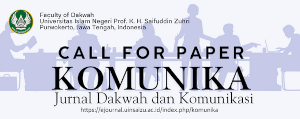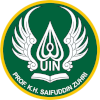Shift Media Online Da’wah Innovation Diffusion in The Hijrah Youth Movement Community
DOI:
https://doi.org/10.24090/komunika.v15i2.4536Keywords:
Youth Movement Community, Youtube, Shift Media, Online Da’wah innovation, AdoptionAbstract
This article discusses the experience the Hijrah Youth Movement Community adopts towards the innovation of online da’wah youtube. This research uses constructionism and phenomenological methods using Everett Rogers’ innovation diffusion theory. In-depth interview techniques, observations, and documentation are used for data gathering. Data analysis with statement meaning, meaning themes, General Description of the “essence” of the experiences. This study showed that the Hijrah Youth Movement Community conducted online da’wah with lectures on youtube and adopted shift media innovations. The audience knows youtube Youth Hijrah Shift Media through persuasive communication of managers and social media Instagram Shift Media. The decision to adopt youtube innovation Youth Hijrah Shift Media. Implement youtube Pemuda Hijrah Shift Media since first knowing the existence of youtube Pemuda Hijrah Shift Media. Confirmation of the innovation of the Hijrah Shift Media Youth Movement is satisfied. The Hijrah Youth Movement Community adopted the innovation of online da’wah youtube Youth Hijrah Shift Media because it has conformity and provides relative advantages to the Hijrah Youth CommunityDownloads
Download data is not yet available.
References
Afrini, I. (2009). Metode Penelitian Kontemporer Kualitatif. Pers.
Ancok, D. (2012). Psikologi Kepemimpinan & Inovasi. Erlangga.
Azis, M. A. (2009). Ilmu Dakwah Edisi Revis. Kencana.
Bungin, B. (2006). Sosiologi Komunikasi: Teori, Paradigma, dan Diskursus Teknologi Komunikasi di Masyarakat. Kencana Prenadamedia Group.
Farkas, J. J. S., & Neumayer, C. (2018). Cloaked Facebook pages: Exploring fake Islamist propaganda in social media. New Media & Society, 20(5), 1850–1867.
Fitiani, A. (2018). Analisis Isi Pesan Dakwah Udztad Hanan Attaki dalam Akun Youtube Pemuda Hijrah.
Gruzd, A. J. J., Wellman, B., & H, P. (2017). Social Media and Society: Introduction to the Special Issue. American Behavioral Scientist, 61(7), 647–652.
Ilahi, W. (2010). Komunikasi Dakwah. PT. Remaja Rosdakarya.
Rogers, E. (1983). Diffution of Innovation. Collier Macmillan Publisher.
Rusadi, U. (2015). Kajian Media: Isu Ideologis dalam Perspektif, Teori dan Metode. PT Rajagrafindo Persada.
Solihat, I. (2017). Strategi Komunikasi Persuasif Pengurus Gerakan Pemuda Hijrah dalam Berdakwah. UIN Syarif Hidayatullah Jakarta.
Yunus, S. (2010). Jurnalistik Terapan. Graha Indonesia.
Ancok, D. (2012). Psikologi Kepemimpinan & Inovasi. Erlangga.
Azis, M. A. (2009). Ilmu Dakwah Edisi Revis. Kencana.
Bungin, B. (2006). Sosiologi Komunikasi: Teori, Paradigma, dan Diskursus Teknologi Komunikasi di Masyarakat. Kencana Prenadamedia Group.
Farkas, J. J. S., & Neumayer, C. (2018). Cloaked Facebook pages: Exploring fake Islamist propaganda in social media. New Media & Society, 20(5), 1850–1867.
Fitiani, A. (2018). Analisis Isi Pesan Dakwah Udztad Hanan Attaki dalam Akun Youtube Pemuda Hijrah.
Gruzd, A. J. J., Wellman, B., & H, P. (2017). Social Media and Society: Introduction to the Special Issue. American Behavioral Scientist, 61(7), 647–652.
Ilahi, W. (2010). Komunikasi Dakwah. PT. Remaja Rosdakarya.
Rogers, E. (1983). Diffution of Innovation. Collier Macmillan Publisher.
Rusadi, U. (2015). Kajian Media: Isu Ideologis dalam Perspektif, Teori dan Metode. PT Rajagrafindo Persada.
Solihat, I. (2017). Strategi Komunikasi Persuasif Pengurus Gerakan Pemuda Hijrah dalam Berdakwah. UIN Syarif Hidayatullah Jakarta.
Yunus, S. (2010). Jurnalistik Terapan. Graha Indonesia.

Downloads
Published
2021-10-01
Issue
Section
Articles
License
Authors who publish with this journal agree to the following terms:
- Authors retain copyright and grant the journal right of first publication with the work simultaneously licensed under a Creative Commons Attribution-ShareAlike 4.0 International License that allows others to share the work with an acknowledgement of the work's authorship and initial publication in this journal.
- Authors are able to enter into separate, additional contractual arrangements for the non-exclusive distribution of the journal's published version of the work (e.g., post it to an institutional repository or publish it in a book), with an acknowledgement of its initial publication in this journal.
- Authors are permitted and encouraged to post their work online (e.g., in institutional repositories or on their website) prior to and during the submission process, as it can lead to productive exchanges, as well as earlier and greater citation of published work (See The Effect of Open Access).




























